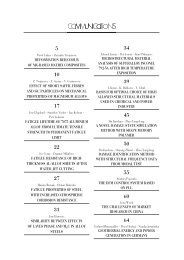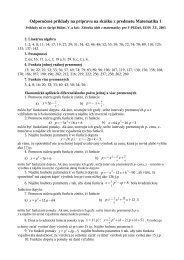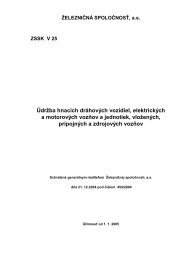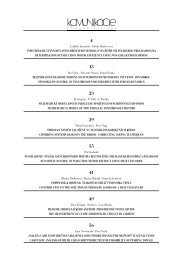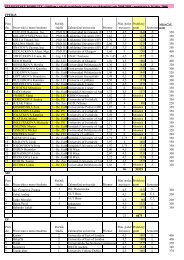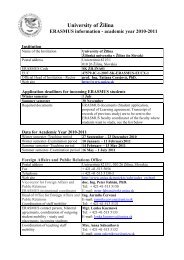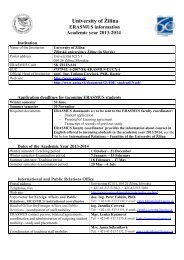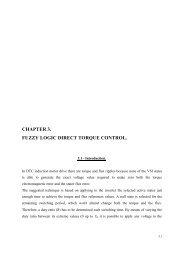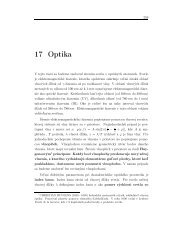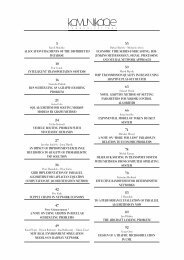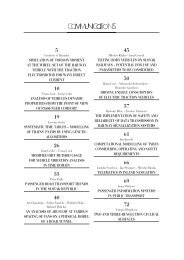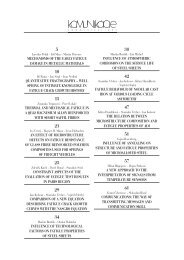posudzovanie vplyvu automobilovej dopravy na ... - Žilinská univerzita
posudzovanie vplyvu automobilovej dopravy na ... - Žilinská univerzita
posudzovanie vplyvu automobilovej dopravy na ... - Žilinská univerzita
Create successful ePaper yourself
Turn your PDF publications into a flip-book with our unique Google optimized e-Paper software.
C O M M U N I C A T I O N S<br />
I S<br />
depends not only on the reducing agent type, but also on the<br />
reactor type used. Iwamoto, who first started to use hydrocarbons<br />
for NO x reduction in the diesel engine exhaust gases by the SCR<br />
method, proved that in the Cu/ZSM-5 zeolitic reactor, reducing<br />
agents such as C 2 H 4 , C 3 H 6 , C 4 H 8 and alcohols demonstrate selective<br />
reducing capability, while H 2 , CO and CH 4 are non-selective<br />
reducing agents with respect to nitrogen oxides [11]. This indicates<br />
that the level of NO x reduction depends on the selective capability<br />
of particular reducing agents. In the case when diesel fuel is<br />
used as the reducing agent source it is difficult to determine its<br />
selective capability, because it depends on the percentage of particular<br />
hydrocarbons or hydrocarbon groups in the fuel. According<br />
to [6, 14], aromatic hydrocarbons are the best reducing agents, followed<br />
by olefins, paraffins, and aldehydes. It must be remembered<br />
that depending on the engine operating conditions, the composition<br />
and amount of unburned hydrocarbons change continuously.<br />
Apart from the selective capability of the reducing agent and the<br />
exhaust gas temperature, at the same relative volumetric flow rate<br />
of exhaust gases SV, the efficiency of NO x reduction is influenced<br />
also by H 2 0, SO 2 , and O 2 [13]. The mechanisms of NO x reduction<br />
in a catalytic converter have been investigated in many papers<br />
summarized in [23], especially interesting being the model presented<br />
by Hamada, proposing two ways of NO x reduction [8].<br />
In view of the above, it may be stated that the fi<strong>na</strong>l effect of<br />
NO x reduction in the diesel engine exhaust gases combines the<br />
results of both thermal (SNR) and catalytic (SCR) reduction.<br />
Partial effects depend not only on the volume of the additio<strong>na</strong>l<br />
injection of fuel being the source of the reducing agent, but also<br />
on the time and temperature at which hydrocarbons are present in<br />
the cylinder before the exhaust valve opens. In order not to burn<br />
the hydrocarbons additio<strong>na</strong>lly introduced into the cylinder, the fuel<br />
post-injection (effected during the expansion stroke) must not be<br />
too early in relation to the injection and combustion of the main<br />
fuel dose. It cannot be effected too late, either, since the temperature<br />
in the cylinder may be too low and the time mentioned above<br />
may be too short. Thus the total NO x reduction efficiency may be<br />
influenced by the following factors: volume of the additio<strong>na</strong>l fuel<br />
dose, timing of fuel post-injection (relative to the expansion stroke),<br />
engine speed and engine load, exhaust gas temperature, oxygen<br />
concentration in the exhaust gases, etc. Diesel fuel composition, i.e.<br />
the content of hydrocarbon groups influencing thermal decomposition<br />
of molecules, may also have a significant effect on the reduction<br />
efficiency.<br />
The idea presented in the paper is based on the simultaneous<br />
implementation of diesel fuel post-injection and a catalytic converter.<br />
It does not require any additio<strong>na</strong>l dosing system for injecting<br />
hydrocarbons before the converter. The method could be implemented<br />
quite easily in widely used common-rail injection systems<br />
which allow the fuel dose injected to be divided into freely adjusted<br />
portions. Such a system of hydrocarbon dosage has been already<br />
indicated in [16], but without any detailed information.<br />
The possibility of using fuel-contained hydrocarbons in the<br />
process of thermal and catalytic reduction of NO x in the diesel<br />
engine exhaust gases has been investigated in the Cracow University<br />
of Technology [3, 19, 20, 21, 22, 23]. Tests were done on the<br />
single-cylinder test engine. For the purpose of tests, a special fuel<br />
supply system was built, consisting of two injection pumps: a main<br />
injection pump delivering fuel necessary for engine operation, and<br />
an additio<strong>na</strong>l injection pump delivering additio<strong>na</strong>l amount of fuel<br />
(hydrocarbons) used for NO x reduction. The pumps were connected<br />
in a row by means of a clutch providing continuous change<br />
of angle between injection the main fuel dose and the additio<strong>na</strong>l<br />
fuel dose. Fuel from both pumps was delivered to the engine cylinder<br />
through the same injector. To elimi<strong>na</strong>te unnecessary interaction<br />
between fuel pressures generated by both pumps, a double check<br />
valve was installed before the injector. A catalytic converter was<br />
installed in the exhaust system. Exhaust gas samples were taken<br />
for a<strong>na</strong>lysis before and after the catalytic converter. Temperature<br />
was measured at the points where samples were taken.<br />
3. NO x reduction efficiency definitions<br />
As it has been mentioned before, owing to a high temperature<br />
in the cylinder and a longer time of initial decomposition of molecules,<br />
first effects of radicals and hydrogen reducing action may<br />
be observed yet in the engine cylinder, and also in the exhaust<br />
manifold between the cylinder and the catalytic converter. The<br />
resultant NOx reduction has the form of Selective Non-Catalytic<br />
Reduction (SNR). In the catalytic converter, however, NO x reduction<br />
is accomplished by Selective Catalytic Reduction (SCR). To<br />
evaluate the effects of both NO x reduction methods, and to evaluate<br />
the total effect, three definitions of NO x reduction efficiency<br />
have been introduced. Auxiliary quantities used for calculations,<br />
together with the points where the exhaust gases were sampled for<br />
a<strong>na</strong>lysis, are shown in Fig. 1.<br />
C 1b C 1p C 2b C 2p<br />
Fig. 1. Quantities used for the calculation of NO x reduction efficiency<br />
where:<br />
C1b – NO x concentration before the catalytic converter, the engine<br />
being supplied only with the main fuel dose (without fuel<br />
post-injection),<br />
C1p – NO x concentration before the catalytic converter, the engine<br />
being supplied with the main and additio<strong>na</strong>l fuel dose (with<br />
fuel post-injection),<br />
C2b – NO x concentration after the catalytic converter, the engine<br />
being supplied only with the main fuel dose (without fuel<br />
post-injection),<br />
C2p – NO x concentration after the catalytic converter, the engine<br />
being supplied with the main and additio<strong>na</strong>l fuel dose (with<br />
fuel post-injection).<br />
28 ● KOMUNIKÁCIE / COMMUNICATIONS 1/2003



